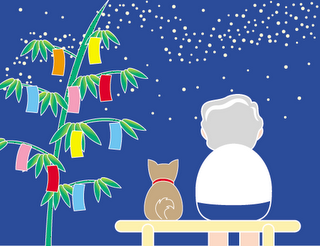
 Japanese Star FestivalJuly 7th is called Tanabata in Japan. It's a Japanese tradition wherein people write their wishes on tanzaku paper (colorful, small strips of paper) and hang them on bamboo branches. People also hang many kinds of paper decorations on bamboo branches and place them outside their houses. People celebrate the day at home and in schools. Many cities and towns hold festivals and have Tanabata displays decorating the main streets. In some regions, people light lanterns and float them on the river, or float bamboo leaves on the river.
Japanese Star FestivalJuly 7th is called Tanabata in Japan. It's a Japanese tradition wherein people write their wishes on tanzaku paper (colorful, small strips of paper) and hang them on bamboo branches. People also hang many kinds of paper decorations on bamboo branches and place them outside their houses. People celebrate the day at home and in schools. Many cities and towns hold festivals and have Tanabata displays decorating the main streets. In some regions, people light lanterns and float them on the river, or float bamboo leaves on the river.The most common Tanabata decorations are
 colorful streamers. Streamers are said to symbolize the weaving of threads. Other common decorations are Toami (casting net), which means good luck for fishing and farming and Kinchaku (bag), which means wealth.
colorful streamers. Streamers are said to symbolize the weaving of threads. Other common decorations are Toami (casting net), which means good luck for fishing and farming and Kinchaku (bag), which means wealth.Tanabata originated more than 2000 years ago with an old Chinese tale called Kikkoden.
Once there was a weaver princess named Orihime and a cow herder prince named Hikoboshi living in space. After they got together, they were playing all the time and forgot their jobs. The king was angry at them and separated them on opposite sides of the Amanogawa River (Milky Way). The king allowed them to meet only once a year on July 7th. This is why Tanabata is also called the Star Festival. People say that Orihime and Hikoboshi can't meet each other if July 7th is rainy, so they pray for good weather and also make wishes for themselves. In many regions in Japan, Tanabata is celebrated on August 7th (which is near July 7th on the lunar calendar) instead of July 7th.


0 件のコメント:
コメントを投稿